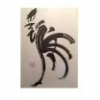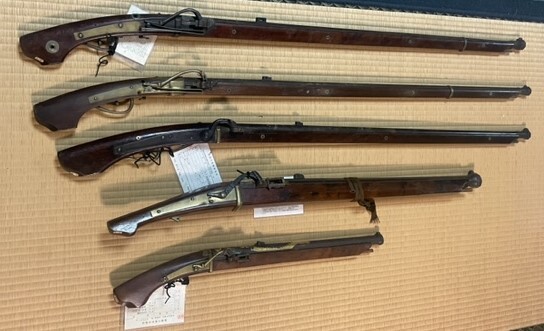-
Posts
926 -
Joined
-
Last visited
-
Days Won
15
Content Type
Profiles
Forums
Events
Store
Downloads
Gallery
Everything posted by mecox
-

Some teppo pics/info for gun enthusiasts
mecox replied to mecox's topic in Tanegashima / Teppo / Hinawajū
-
On the recent trip to Japan visiting family I found one had some teppo. I took pics for NMB gun folk and translated Torokusho. There are five. Please note I have zip knowledge about Japanese firearms. Below are the five, plus 5 pics for Teppo #1. Others to follow.
-
-
Brian, a rather crude fake, and seems to have been "aged" somehow. Cast fuchi and kabuto gane very poor, hole in latter is rough and no eyelet. Maybe the sarute is OK but cant see all. Ito is different type of material and is black, plus poorly bound. menuki hard to see but looks a mess and is black? Same is rough and falling off. Nakago is just rubbish, crude yasurime and yes the mune machi way off....maybe to fit a crude habaki?
-
Thanks Bruce, reaxxy xery usefux and hope you can get a new keypad soon. cheers Mal
-
I went forth and studied (including F&G's) then came to my question.
-
Wife's family in Japan have this sword. Any ideas on what it is....looks like a police sword?? Blade could be handmade, looks to have weak suguha hamon, nagasa is 45.5 cm, bohi on both sides, habaki is gilt covered copper but filed off in part. Saya is steel with one ring and is chrome plated. Tsuka: all fittings are brass, grip is worn lacquered wood with twisted wire bands. Has a retention pin. Lower seppa is leather. Could not see any stamps on sword or saya, but on solid round "cross guard" end is a character roughly cut (owner?). Thanks, Mal
-

An interesting sword that has conflicting opinions
mecox replied to Jw22a's topic in General Nihonto Related Discussion
Jon, your man did do some good work. examples (with computer translation) 尾州住竹内兼正作・昭和二十年二月|刀剣・日本刀販売の【黒金の舎】 (kajiyahiroshi.com) Characteristics: Kanemasa, whose real name was Takeuchi Kanesaburo, lived in Torii-matsu-cho, Kasugai City, Aichi Prefecture, and was an Army-appointed swordsmith. This sword was made in 1945, near the end of the war, but the blade has enough raw edges to suggest that it was not used in practice until the end of the war. The sword is characterized by its extremely thick and wide sturdy construction, and its weight is very heavy for its size. 日本刀 刀 尾州高蔵寺住竹内兼正作|日本刀 刀剣販売 e-sword His real name is Takeuchi Kanezaburo, and he lived in Izukawa, Takazoji-cho, Higashi-Kasugai-gun, Aichi Prefecture, and later moved to Tori-cho. He was a former army swordsmith, and was selected for the Army Military Sword Technique Encouragement Society. 312 時代武具 刀拵 尾州住竹内兼正作 昭和二十年三月 刃長64.8㎝ 現代刀 変形透鍔 大目貫 小尻 元幅3.33重0.77㎝先幅2.22重0.5㎝(刀、太刀)|売買されたオークション情報、yahooの商品情報をアーカイブ公開 - オークファン(aucfan.com) Sword by Takeuchi Kanemasa, Bishu, March 1945, blade length 64.8 cm, modern sword, variant through-barrel tsubasa, large mokutsu, small butt, original width 3.33 cm, weight 0.77 cm, tip width 2.22 cm, weight 0.5 cm. 現代刀 尾州住竹内兼光作 二尺二寸二分 白鞘入 拵付 | 日本刀・刀剣総合専門店『儀平屋』 (giheiya.com) The blade is well made with itame-zukushi, and the ground is slightly boiled with some ground sceneries. length 67.3 cm. The blade has a clove-shaped pattern with a flattened blade and well-defined legs. The blade is lightly boiled and has a sandy streamer. The cap is slightly rounded with a disordered pattern. Takeuchi Kanemitsu, a swordsmith active from the Taisho era to the prewar period, resided in Asai, Ichinomiya City, Aichi Prefecture. He is a former army swordsmith and was selected by the Army Military Sword Technical Encouragement Society. Kanemitsu was not a military sword maker, but a purely Japanese sword maker, and some of his works are certified as preserved swords. This sword was also made as an art sword, and we regret that we are unable to show you the quality of the workmanship in the photos. -

An interesting sword that has conflicting opinions
mecox replied to Jw22a's topic in General Nihonto Related Discussion
Jon and John, mei reads Bishu/Owari Kanemasa.......so could be this one from Sesko: KANEMASA (兼正), Shōwa (昭和, 1926-1989), Aichi – “Bishū-jū Takeuchi Kanemasa kore o saku” (尾州住竹内兼正作之), “Bishū Kōzōji-jū Takeuchi Kanemasa” (尾州高蔵寺住竹内兼正), real name Takeuchi Kanesaburō (竹内兼三郎, the first name can also read Kenzaburō), rikugun-jumei-tōshō, he was no longer working as a swordsmith after World War II, Fifth Seat at the 6th Shinsaku Nihontō Denrankai (新作日本刀展覧会, 1941) -
History, politics, the range of edged weapons, the display itself........
-
Hamfish, its the context, nothing to do with the quality.
-
An article in ABC (Australia) news online: "Like the ravages of the Cultural Revolution in the 1960s and the Tiananmen Square massacre in 1989, China now appears to be embarking on a campaign of coerced, collective amnesia about the crackdown in Xinjiang. A museum in the capital Urumqi, dedicated to "The Fight Against Terrorism and Extremism in Xinjiang", outlines in glossy, gory detail the period of bloody unrest in the province." Figure caption: " Weapons are on display at a museum in Urumqi, dedicated to "The Fight Against Terrorism and Extremism in Xinjiang". (ABC News: David Lipson)" A katana at front with "kinzogan" tsuba and possibly 2 or 3 at other end near camera woman. Maybe one is a gunto?
-
Very hard to see, not sure....tend to agree with Piers with 兼高 Kanetaka
-
Kent, info on your smith Masahiro and examples:
-
Darrel, there is a bit about Kanewaka tosho in NMB:
-
Peter: Yoshifusa
-
Jon, its a NBTHK Nintei (certificate) dated Showa 46 (1971) March 10 for mei Uda Kunimitsu. Doesnt mention generation but Sesko has 5 generations in Etchu from 1317 to 1501. Nagasa is 2 shaku, 1 sun, 4 bu is around 64.83 cm. Owner of swords may be Uchida Hayatoshi
-
Joe, reads as Noshu Seki Ju Kanemichi Oite Yasuki (Yasugi) Hagane Tsukuru Kore "Kanemichi of Seki in Mino forged this using Yasuki steel" (quality steel from Shimane) Info here:
-
Simon, Kanefusa summarised here:
-
JK, as noted by Ray S, mei is Hizen Ju Kunimitsu and date is Showa ju kyu nen ju gatsu (Showa 19 (1944) October). Also has star stamp of Rikugun Jumei Tosho. Typical Hizen style cut mei. Sesko notes: KUNIMITSU (国光), Saga – “Hizen-jū Kunimitsu saku” (肥前住国光作), real name Shibata Tsuneo (柴田常雄), born 1895, he studied from 1942 under Kurihara Akihide (栗原昭秀) and worked then as rikugun-jumei-tōshō. In 1942 ranking of swordsmiths he was Jōko no Jōi (Akihide) 4 out of 7. In 1941 exhibition he was Fifth Seat at the 6th Shinsaku Nihontō Denrankai (新作日本刀展覧会, 1941). Also in Gendai Toko Meikan 1971. Also translated name as Shibata Tsuneji. Born 3 March 1895 (Meiji 28). Registered as tosho post-war Showa 29 (1954) January 16. Showa 13 (1938) went to war zone to make swords (maybe Manchuria?). Showa 17 (1942) enrolled in Zama Tanrenjo of Kurihara Hikosaburo (Akihide). Showa 18 (1943) June became Rikugun Jumei Tosho by Kokura Zoheisho (arsenal). Note: The Kokura arsenal was at Kitakyushu, near Fukuoka in N Kyushu and was established there in October 1935, after the original one in Tokyo was destroyed in the Great Kanto Earthquake of September 1923. Note: In Tokyo Kindai Tosho (Chris Bowen) Kunimitsu is listed as a student of Akiyoshi (Yoshikane) who was a student of Akihide.
-
That "square" cutting style of mei kanji is interesting and common for tosho on Kyushu.
-
As Brian notes painted characters are typically assembly numbers for racks or to match the fittings. Yes looks to be 地五九. which could be 地 5 9, where 地 is "Ji" could mean "earth". But if the three read together, sounds like "ji go ku" which could mean "hell". But when i looked online also suggests "Also named the sexagenary cycle or the stem-branch cycle, the Chinese 60-year calendar cycle is based on the combinations of a cycle of ten heavenly stems and twelve earthly branches. But maybe date does not fit.
-
Bruce, Hattori Masahiro is discussed here with examples:
-

Showa smith Munetsugu (Tanaka?) info, please.
mecox replied to John C's topic in Military Swords of Japan
John, for Tanaka Munetsugu all I could find was he was from Tochigi (old Shimotsuke or Yashu) in NE Honshu. Also a smith of that name was a student of Konno Akimune who was a student Kasama Shigetsugu at Denshujo in Tokyo. And he is listed as a RJT. -

For Sale: 1938 Special Order Maeda Family sword
mecox replied to Eric Santucci's topic in Sold Archive
Eric, an anti-rust blade, but still quite interesting. Especially of interest it is pre-WW2 and 1938 at a time when there was experimental work into different steel for sword blades for military use. A leader in this was Fujiwara Eijiro Kanenaga (1887-1943) originally trained in Seki but went on to develop/work with anti-rust steel. He was in my opinion a brilliant metal artist as well as swordsmith (see in NMB Downloads Naval Swords #1). Kanenaga also worked at Tenshozan Tanrenjo in Kamakura (that produced for the Navy). There were other tosho working there in development as well. Not confirmed, and although your Morimichi (守道)does not appear in any records I can find, there is a good chance he worked there also. Very similar work to Kanenaga, similar style artistic mei and the same metal and very nicely made with good detail. This anti-rust steel was early on called "Fusabiko" or probably on yours "Fuseiko", but the term used later was "Taiseiko". As noted, your blade has "Motte Nihon Tokushu Hagane Kaisha Fuseiko Kore Saku Morimichi kakihan" (Morimichi made this using Japan Special Steel Company anti-rust steel). On reverse: "Made for Maeda Shi" with date of Showa 13 (1938) 5th month (May). Interesting to find another example in Fuller & Gregory (1983) "Motte Nippon Tokushu Hagane Kore Saku Morimichi kakihan" (maybe can read as, Morimichi made this using Japan Special steel). The date is Showa 13 (1938) 8th month (August). With a name "Mitani Sadatoshi" 神谷 貞利 presumably the person who ordered it. But as I note, this is a possibility and not confirmed. Also they are likely to have been mounted as kaigunto.










